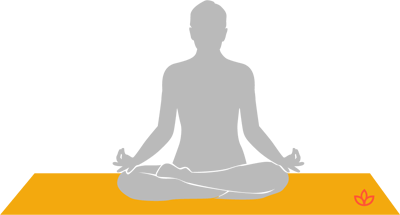I’ve written a lot about mindfulness and meditation as effective mental health tools to relieve symptoms of anxiety, depression, and even trauma. (Learn more in How Meditation Can Help Soothe Your Stress and Anxiety.)
However, it is important to make distinctions about people who have experienced trauma as they may face specific challenges. Being trauma informed is important for leaders, doctors, teachers, yogis, spiritual seekers of all kinds, family members, friends and everyone else.
It is the path towards honoring that some people experience trauma, and becoming compassionate towards every unique individual and their story.
In this article, I will talk about what it means to be trauma informed, why thinking about traumatic memories can make trauma worse, the difference between being mindful and meditating, and how to connect with your own inner guide by listening to your body.
Trauma is relative to the person who has experienced it. For many, more opportunities to process and understand what has happened after experiencing trauma results in releasing and healing. (Learn more in The Body Remembers: How Your Body is Storing Past Trauma.)
Trauma can be one single event or repetitive and long term. Some examples include rape, childhood abuse, and exposure to war. Some people develop Post Traumatic Stress Disorder (PTSD) after experiencing a traumatic or stressful event, but this depends on a number of unique factors. By definition, someone diagnosed with PTSD experiences: 1. Reliving the event(s); 2. Avoiding reminders of the event; and 3. Experiencing increased arousal as a result of the event.
Being trauma informed means learning about trauma.
You can consider this knowledge and understanding when adjusting your behavior so that people will not experience an increase of reliving, avoiding, and arousal related to their trauma. For example, a trauma informed yoga teacher may avoid hands-on assists without consent. This consent could be very important for someone who has experienced rape or sexual assault, which an extremely common form of trauma.
Being With “What Is” Doesn’t Always Help If “It” Is Traumatic Memories
Someone who is experiencing symptoms of PTSD could be living with flashbacks of their trauma and periods of dissociation. Some studies have shown that sitting in stillness and practicing certain styles of meditation, such as silent Buddhist meditation, can trigger flashbacks, leading to states of dissociation and even psychosis.
When left to its own devices, the traumatized mind may flood the person with images and memories of the trauma. When the mind thinks about trauma, it produces the same neurochemical state in the body and brain as it did when the trauma occurred, as if it is happening again in the present moment. This disconnects the mind-body out of sheer survival, just as it did when the trauma originally occurred.

It is important to understand that there is a big difference between awareness of what is happening in the mind, and distressing rumination or full-blown trauma flashbacks. Mindfulness is present moment awareness, so any method of meditation that pulls the mind into the past or promotes dissociation inherently has a cost that threatens this vital component.
Someone who has experienced trauma typically has an over-activated sympathetic nervous system – the part that is responsible for the fight or flight response. Re-regulating this system to respond appropriately to non-threatening stimuli is challenging, but possible.
The goal for someone who has experienced trauma – and for everyone, really – is to activate the parasympathetic nervous system so that the body can rest and the mind can be still.
For someone who has experienced trauma, the body and mind must be gently retaught to relax. While I’ve written about how meditation has been shown to do this by reducing cortisol levels and reducing stress, it is vital to keep a trauma-informed lens because this helps us understand how it could potentially produce the opposite effect.
Mindfulness Versus Meditation
There is a difference between being mindful and being in a state of meditation.

To be totally clear, meditation is not sitting in half lotus position while waiting for enlightenment to strike you like lightning, either. Mindfulness is practising being present by noticing what is happening in the moment, internally and externally. (Learn more in Meditation & Mindfulness: What's the Difference?)
Meditation is the state of pure consciousness where the thoughts cease, and being. Mindfulness can lead you into a meditative state.
For someone who has experienced trauma, being mindful could potentially bring observations of repetitive traumatic thoughts or memories. This practice is no longer helpful.
An initial awareness of thoughts can be helpful, but ruminating in thoughts of the past is not presence or mindfulness.
Typically, a trauma survivor requires more than mindfulness to heal and integrate trauma. Instead of sitting in a silent meditation and becoming increasingly distressed, they could practice a type of active mindfulness that allows them to notice the present moment within their purposeful actions, such as:
Being trauma informed means being flexible enough to offer gentle invitations to modify any activity. (Learn more in Managing Your Emotions: The How and the Why.)
It means asking before touching someone, no matter what your role is. As a practitioner who may have experienced trauma, it means allowing yourself the space to find what works for you. It means giving yourself permission to feel safe.
Many people turn to meditation and yoga because they have experienced trauma, so this is vital information for all yogis and meditators to consider.
As always, the work must begin with honesty and integrity within your own practice.
The last thing a person who has experienced trauma needs is to condition themselves to fear their meditation practice as a source of re-traumatization!
If it is distressing, especially to the point where the person is experiencing flashbacks or dissociating, then it should be STOPPED and possibly revisited another time from a completely calm state.
Trauma survivors could work with mindfulness tools that focus on grounding into the present moment’s reality instead. My favorite grounding tool to teach to people who have experienced trauma is the practice of moving mindfully through each of the senses. This tool allows for mindful observation of the environment.

Being trauma informed doesn’t mean you can prevent yourself or another person having some sort of traumatic flashback or emotional reaction. Instead, it means that you are open to learning about trauma, how it affects yourself or other people, and able to cultivate compassion towards others.
As a yoga teacher and mental health therapist, I teach that you can soothe anxiety caused by trauma with restorative yoga and because I am trauma-informed, I know that certain poses could be triggering for some people. (Learn more in Soothing Anxiety With Restorative Yoga.)
This is why I watch my classes for clues of discomfort and apprehension during all poses and transitions, all the while being gentle with my instructions so they seem like invitations, not orders, and by offering modifications, and reminding people to check in with their bodies to feel what is right for them.

For example, a pose that requires students to lay on their backs with their legs open (like Reclined Bound Angle) may feel too vulnerable, so something like Supported Fish may be a good alternative to offer.
In the end, you cannot control if someone has experienced trauma or their reaction to it. All you can do, especially yoga and meditation teachers and practitioners, is encourage safety and foster a healthy mind-body connection through gentle reminders that cultivate bodily awareness.
Connect With The Inner Guide
At the crux, research shows us that trauma interrupts the mind-body connection. Meditation is best practised from a place of connection. If someone is dissociated, meditation could strengthen the disconnect and create even more distress.
Therefore, using mindfulness tools to foster body-mind connection and using grounding are better options for people who have experienced trauma. For these people, working with a mental health therapist that understands the mind-body connection is another great tool.
To me, trauma informed mindfulness means remaining adaptable and fostering connection to the body grounded in the present moment. As leaders and practitioners, you can practice this by allowing yourself and students to favor their own inner guide over teachers.
Everyone must listen to themselves when discerning what practices work for them and which do not.
During These Times of Stress and Uncertainty Your Doshas May Be Unbalanced.
To help you bring attention to your doshas and to identify what your predominant dosha is, we created the following quiz.
Try not to stress over every question, but simply answer based off your intuition. After all, you know yourself better than anyone else.